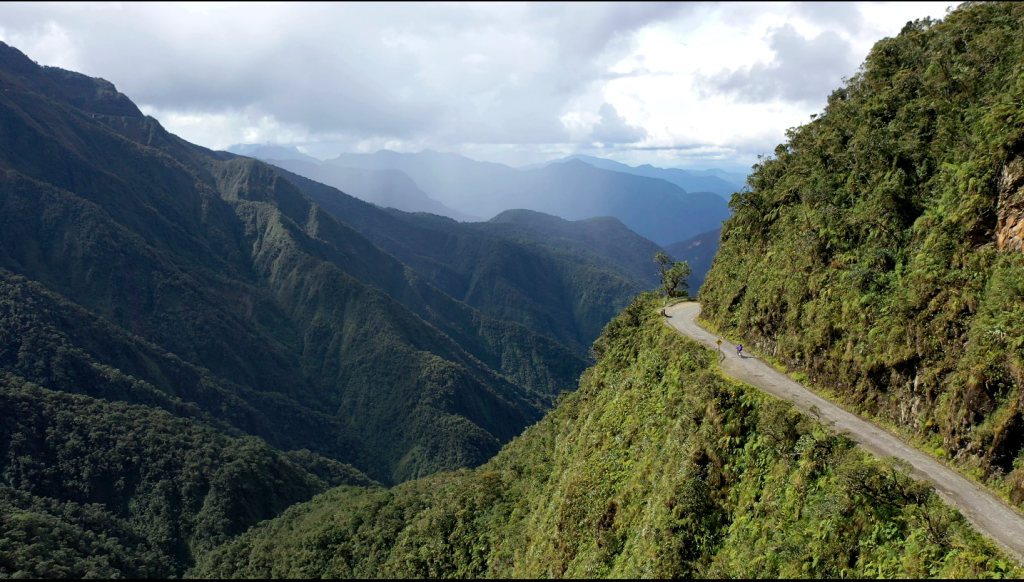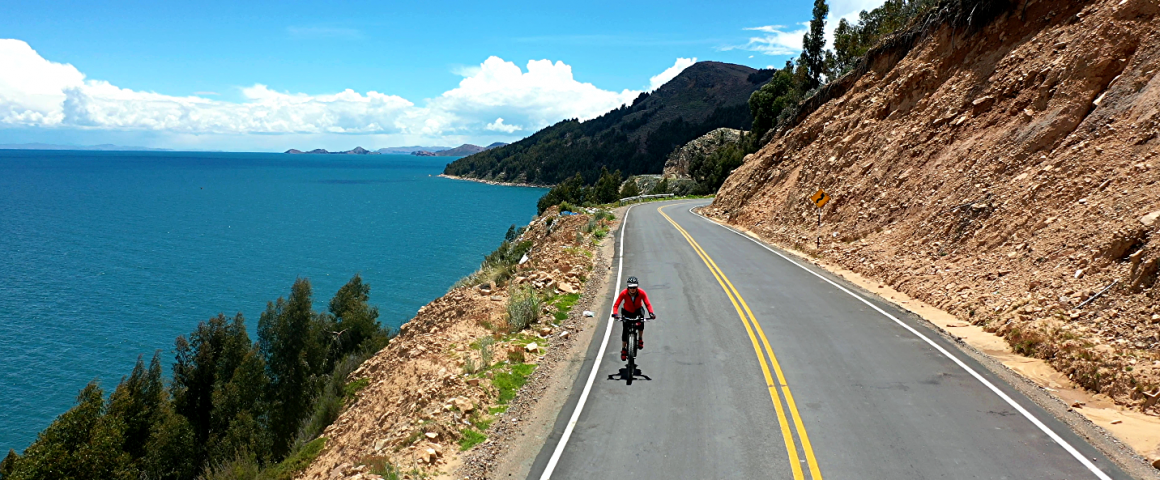By Kate Leeming
When I left Australia on 26 February, bound for South America to do an eight-week altitude cycle expedition from Cusco in Peru, through Bolivia, Chile and Argentina, I obviously knew about COVID-19 but never considered it would pose a threat to the successful completion of the journey.
I was focussed on making the challenging journey a success and had already received a few curveballs. With less than three weeks to go, the filmmaker who’d committed to accompany me on a motorbike had to pull out. I managed to put together a Plan B with Chris Pennington, an emerging young adventure filmmaker, agreeing to join me for six weeks of the journey from La Paz, Bolivia. And then, in the nick of time, a Peruvian film producer managed to find me a local filmmaker and fixer to accompany for the first ten days. Finding reliable vehicle support in the different countries to enable the journey to be filmed was also a complicated last-minute operation.
The journey’s start through southern Peru was a great success; exploring ancient Inca sites such as Cusco, Machu Picchu and the Sacred Valley, then diverting into the highlands to extend myself in the rarified air at over 5000m of altitude, and finally passing through the fertile agricultural landscapes in the south around Lake Titicaca’s turquoise waters. During this time, I was keeping an eye on the COVID-19 situation. I believed I was in one of the best places, considering that I was generally travelling through remote countryside and on the continent farthest from the virus action.
When Chris joined me in La Paz, he gave a firsthand account of how the situation was ramping up in Australia. We soon learned we would have to go into two weeks of self-isolation when we returned. It didn’t seem much to worry about at the time; it was at least six weeks away. Things could change. I was happy I was able to write blogs full of positive stories for people to enjoy. I hoped that schools in Australia and around the world would be able to take part in the lessons created specifically for the project – about the Global Goals and leadership.
In the meantime, I’d been thrown another curveball; the driver I had employed for Bolivia and Chile had suffered a motorbike accident and was in hospital. Fortunately, at the last minute, I managed to find another reliable driver, Rolando, from southern Bolivia.
Setting off from La Paz and over another high pass before dropping down into the rainforest of the South Yungas and taking on Death Road, I still wasn’t worried. We noted, however, that not only Australia, China, Europe and the US were introducing more restrictions, but now South American countries were imposing new laws. On my third day out from La Paz, the situation became untenable. Argentina had closed its borders, Chile was about to, and schools were closing. This all meant that I wouldn’t be able to achieve any of the expedition’s planned outcomes. Having only completed about a third of the journey, I reluctantly made the decision to postpone it and to return to Australia to wait until the crisis was under control.

On the five-hour drive back to La Paz, Qantas announced it was grounding 95 per cent of its fleet. Suddenly it seemed we may struggle to leave the country. Bolivia then announced it was closing its airport and borders on March 21. We had four days to leave the country. Our travel agent, after he was initially unable to access any flights, managed to find us seats on the last flight out on 20 March. We thought we were secure, but then the Bolivian government changed the date, announcing that all foreigners had to be out by 11.59pm on 19 March. Now we were worried. I registered with the honorary Australian consulate in La Paz and the Australian consulate in Peru. I applied to get us on a chartered flight to Sao Paulo the next day, but the opportunity disappeared due to high demand.
Our travel agent was trying everything he could. He was under pressure as other clients also needed flights home – my friends in Svalbard, Norway and other Australians in Canada and Morocco. He couldn’t see any options opening up for Chris and I, and he suggested we get to the airport to see if we could find a flight. A curfew had just been implemented in La Paz that evening, from 5pm to 5am. We weren’t meant to be out of our hotel. La Paz had no known cases of COVID-19, and I believe they were locking the city down to protect it.
Rolando, our driver, was from Uyuni in the country’s south but he hadn’t been able to return because of the lock-down. He returned to help us out. All taxis and public transport had been stopped – we couldn’t have moved without Rolando. We loaded his vehicle and made a dash for the airport. The main city of La Paz is located in a deep valley with the airport built on flatter land about 500m higher than the city centre. Normally the city is gridlocked with traffic, but setting off to the airport, the streets were eerily empty, except for the police and military – they were everywhere. The government had warned that anyone found out after 5pm could be arrested, but we decided we had to take the chance. Kudos to Rolando, who risked all to help us! Not far from our hotel we were stopped by a policewoman. Rolando showed her my passport and explained we were from the Australian consulate and were heading for the airport to leave the country. She seemed okay with that and let us move on. From that point Rolando stopped for nothing. He ran every red light and avoided or went through barriers.
There was no joy at the airport. Latam Airways was grounded, and there were no flights or airline representatives to speak to. We decided we should return to our hotel, hoping we could get on a mercy charter flight. It was a big decision to return as we were worried about being detained by the armed forces. Again, Rolando stopped for nothing, driving steadily through every red light and barrier and, once near the city centre, taking back routes to avoid the security forces. Even the stray dogs around the city looked puzzled at the absence of traffic!
We were relieved to be back at the hotel, which was comfortable and secure. The place was formerly the Panamanian consulate and the managers were extremely supportive. By this stage, we were almost resigned to the fact that we were stuck there at least until the 31 March when the government was going to review the lockdown situation. The worry was that this restriction could be extended for months, and with all of the airlines grounded, there would be no way out even then. The hotel managers initially assured us they weren’t going to close, but it was likely the government would soon order all hotels to shut their doors, as has already happened in Peru. With the situation being so fluid, uncertainty was the most disturbing issue. We didn’t know who or what to believe anymore.
Colin, my travel agent, got to work once more. The only country in South America still open was Brazil, and we had to try to go through Sao Paulo. It was after midnight when an opportunity opened and Colin was able to book us both on the flights. At 3am, Rolando drove us nonstop back to the airport. We were still very nervous that the authorities might arrest us, but this time we weren’t stopped. With no sleep and way more luggage than we were permitted to have on the internal flight, I didn’t relax until we had our boarding passes. Our transit time was 53 hours, traveling via Santa Cruz (Bolivia), Sao Paulo (Brazil) and Dubai to Melbourne.
Over the last 30 years, I have cycled a distance equivalent to more than twice the Earth’s circumference on my major journeys and on every continent (except Antarctica – that’s next), and I’ve had to deal with all sorts of curveballs. However, all my major expeditions have finished on time, on budget, with no significant injuries and all key missions achieved. No successful expedition is void of obstacles and inconveniences. Each journey has required that I adapt to the ever-changing conditions and maintain a positive attitude to be successful. The key is to focus on what’s needed to get through safely rather than be blinded by curveballs and negatives that could be perceived as obstacles that might stop me.
I have cycled through some of the most remote corners of the world – the Australian outback, Svalbard, Greenland, Arctic Canada and remote Himalayan regions and through many developing countries – through 20 countries across Africa (Senegal to Somalia), in India and now in Peru and Bolivia. I am always inspired by the spirit of these communities; how they manage with what they have and create, and how they adapt to the conditions and pull together in difficult times.
By contrast, I live in one of the ‘world’s most liveable cities’. I can access just about any food I like from anywhere in the world. Basic services are taken for granted. Young people have access to a quality education. But it’s also a city where there are increasing mental health issues, increasing numbers of people feeling isolated and, in general, people becoming less in touch with what I think of as ‘the real world’.
Despite the general inconveniences and restrictions in place to control the COVID-19 virus, maybe this is an opportunity for we, in the developed world, to reset and take in some lessons from the developing world: Build closer communities. Don’t take conveniences for granted. Grow some of our own food. Stop ‘needing’ products that have been transported half-way around the world.
Everyone gets thrown curveballs. The key is not to be blinded by fear and negatives. To get through it is always a case of adapting, pulling together and looking for the positives – focusing on how we get through rather than not being able to see past the negatives and what might stop us.
Contact and support Kate and find out more about her journeys and education programme at www.breakingthecycle.education


